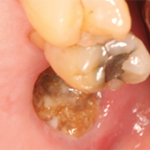
CHICAGO—During the ACR’s 2014 State-of-the-Art Clinical Symposium, Beatrice Edwards, MD, MPH, associate professor and geriatrician in the Department of General Internal Medicine at the M.D. Anderson Cancer Center at the University of Texas, said rheumatologists have reason to be optimistic about the prospects of a new treatment for osteoporosis.
Odanacatib
Bisphosphonates inhibit the production of osteoclasts, thus interrupting the normal cycle of bone resorption and formation.
“We’ve all heard the concerns with bisphosphonates, and the sporadic adverse events have really raised fear in the community,” Dr. Edwards said. One recent study found as many as 20% of patients discontinue their treatment with bisphosphonates.
According to Dr. Edwards, a new drug may soon offer an alternative to bisphosphonates. Odanacatib is a cathepsin-K inhibitor, a mechanism of action that reduces bone resorption without hindering bone formation, which is a primary problem with bisphosphonates.
“Cathepsin-K inhibitors only work on the enzyme and won’t affect the number or viability of osteoclasts,” Dr. Edwards said.
High-resolution quantitative computed tomography imaging of primates given odanacatib show improvements in the biomechanical strength of bone, Dr. Edwards said.
The Evidence
In a three-year, randomized controlled trial, the bone mineral density of the lumbar spine was up nearly 7%,1 “which is greater than what we tend to see in bisphosphonates, so it’s a very robust agent,” Dr. Edwards said.
For the hip, the density increase was almost 4%.
“At all sites studied, this is an agent that will produce an increase in bone density,” Dr. Edwards said.
Dr. Edwards said one concern with bone-resorption medications is that they might linger in the body long after patients stop using them. But that does not appear to be a problem with odanacatib. Graphs over time bear this out, she said.
“You see the bone-resorption markers are down [when use of the drug begins],” she said. “And there’s a discontinuation at 24 months. You see the bone-resorption markers shoot up. What this is telling us is that the drug doesn’t stay in bone very long.”
This is a sharp contrast from bisphosphonates, she noted.
“If you were to do this on bisphosphonates and you treated people for two years and you monitored their bone resorption markers, you would find that they persist low even after discontinuing the drug,” she said.
Before approval [of odanacatib] by the FDA, investigators will probably have to show that the drug prevents vertebral fractures, which has not yet been demonstrated.
“We are concerned with the drugs persisting in the skeleton,” she said. But with odanacatib, it appears that the metabolism of the bone returns to where it was originally. “This is a very welcome finding. … When you stop it, within two months, you’re starting to see an increase in bone resorption.”

